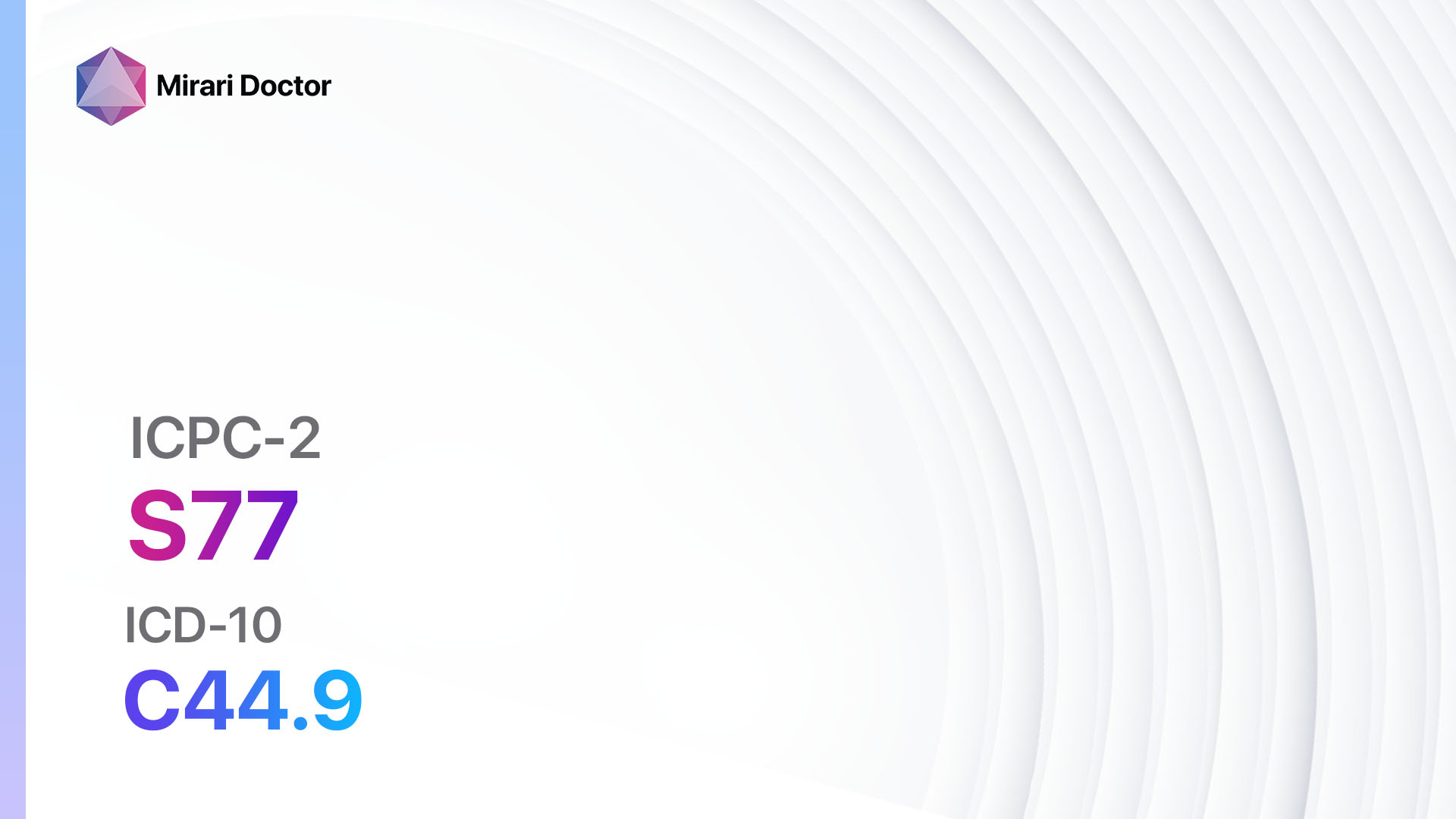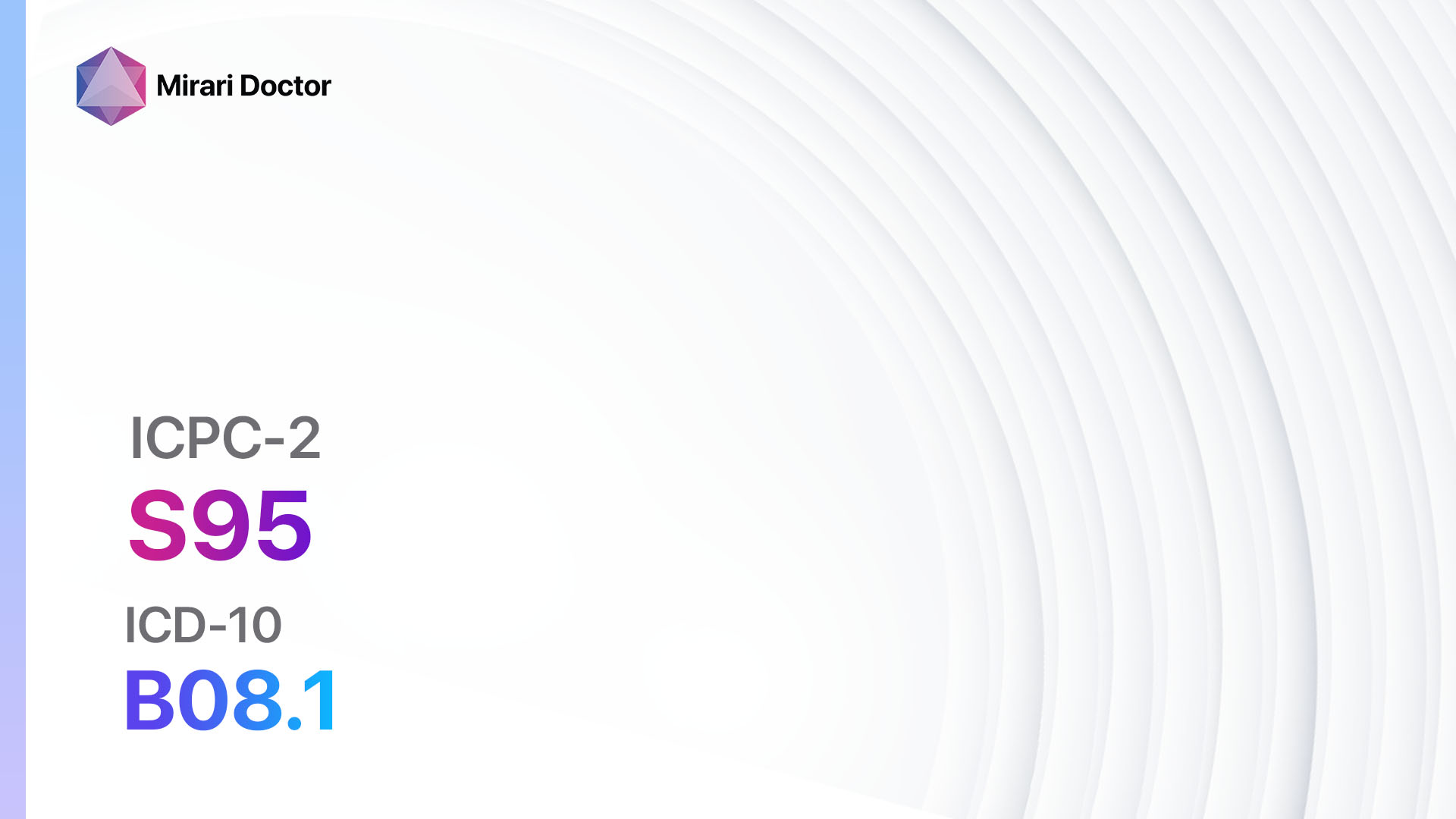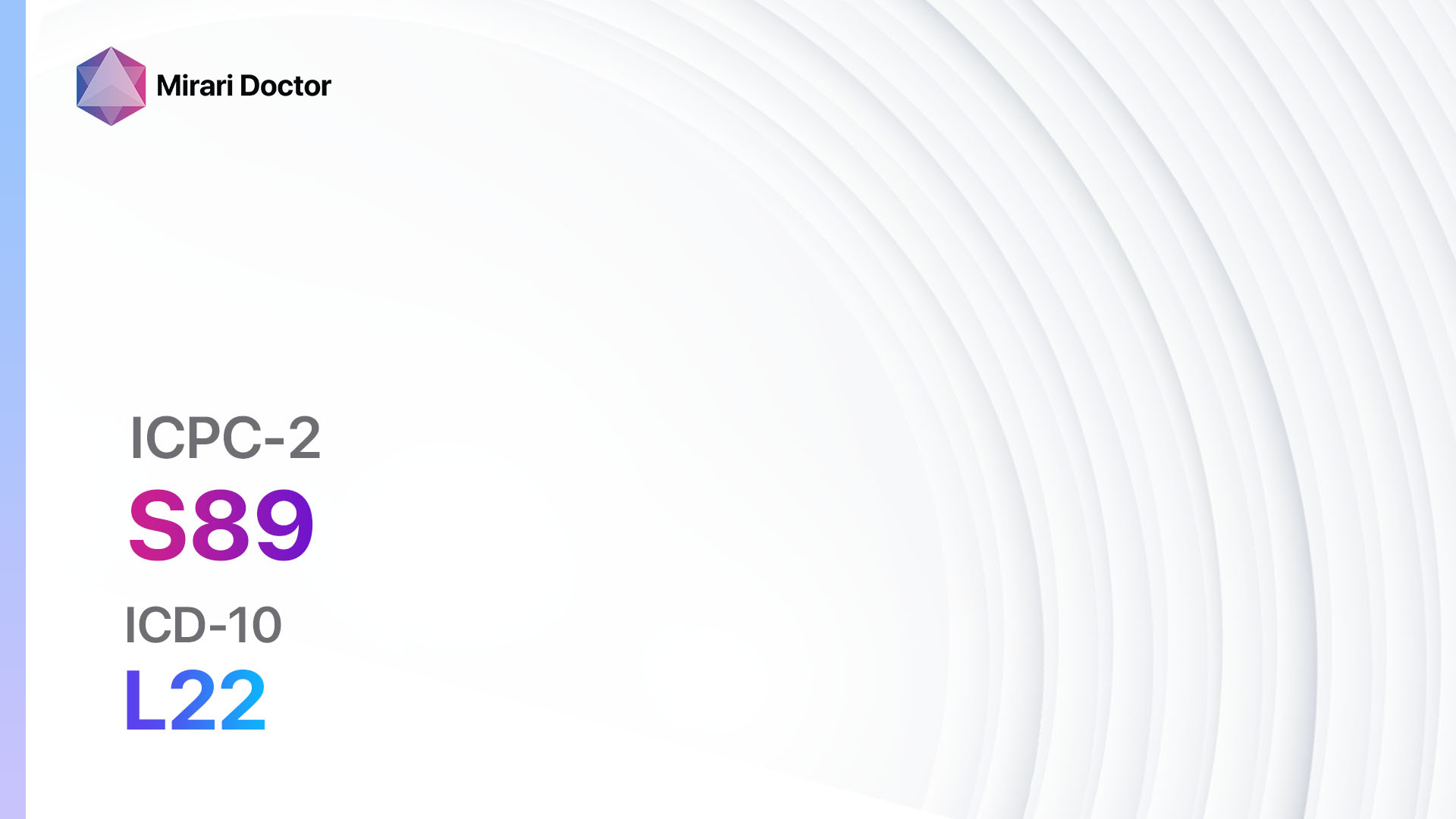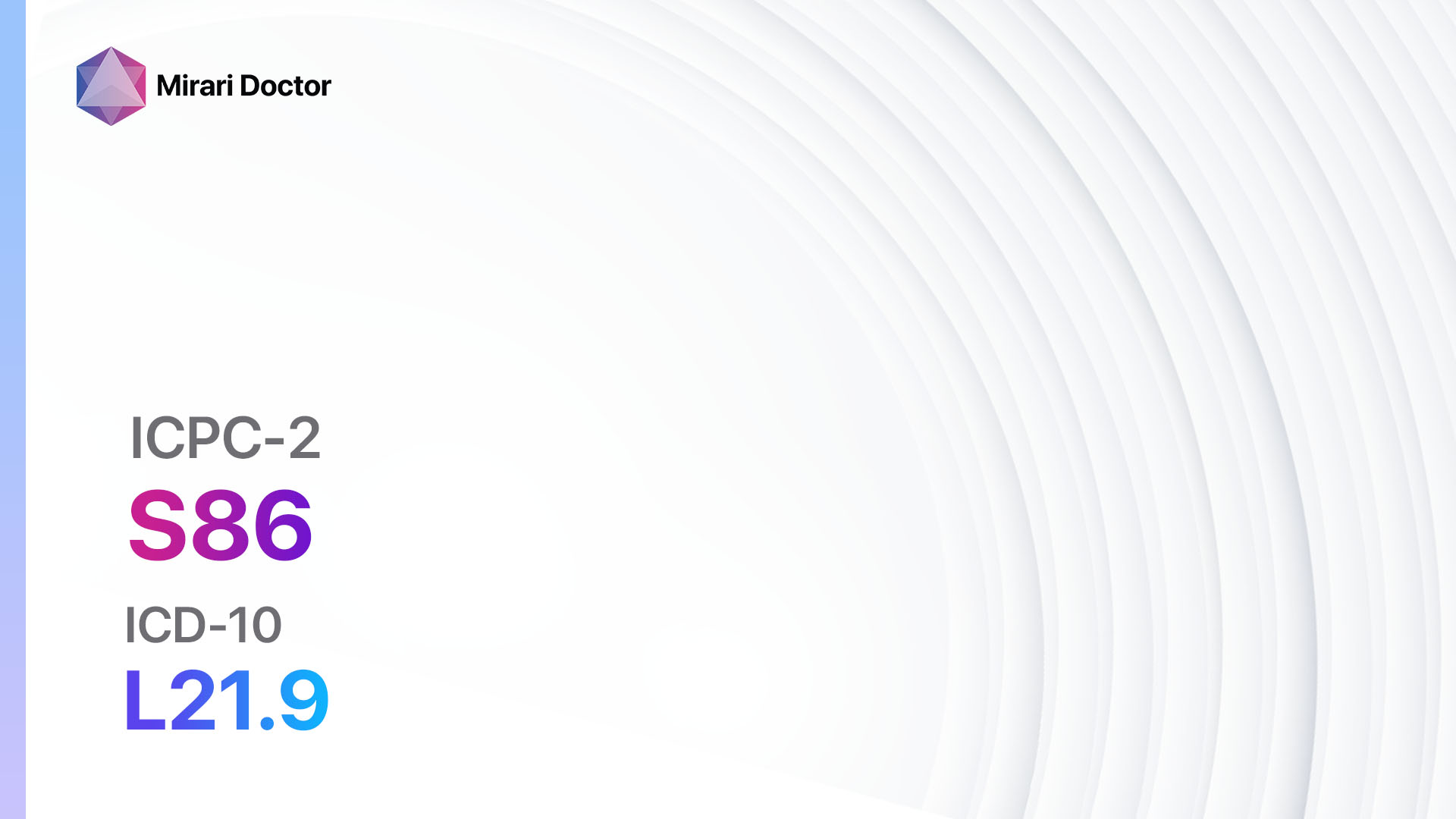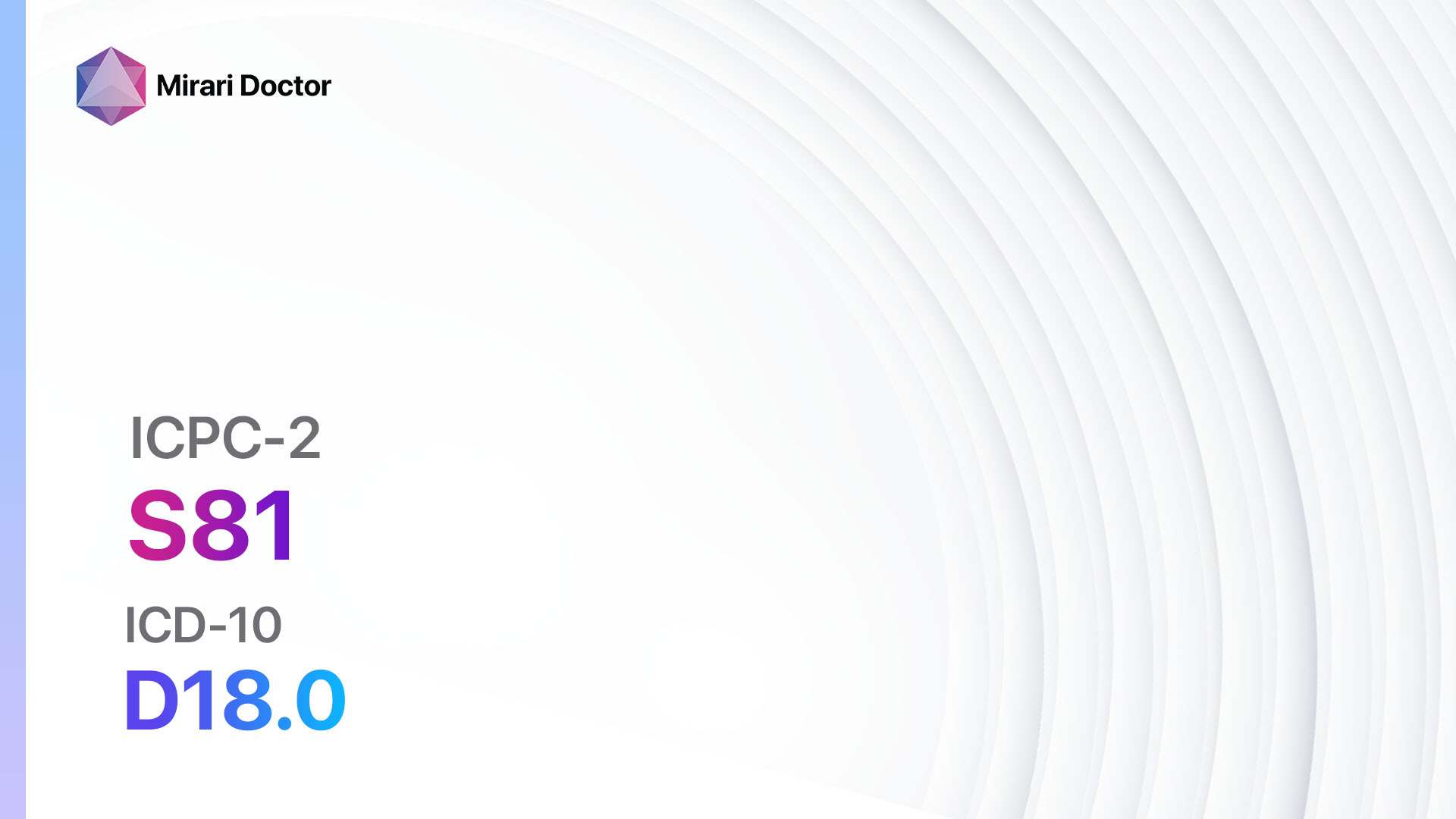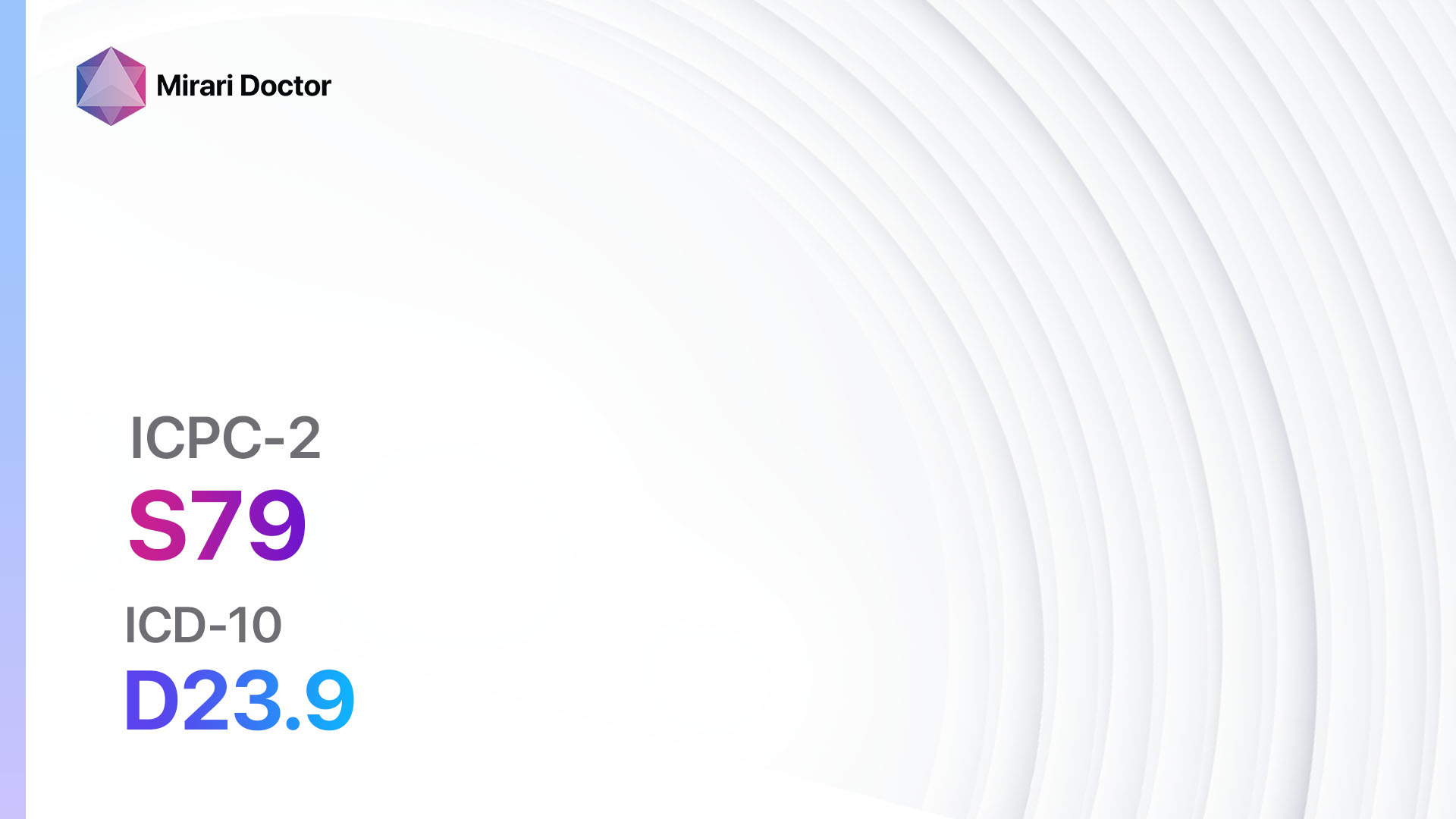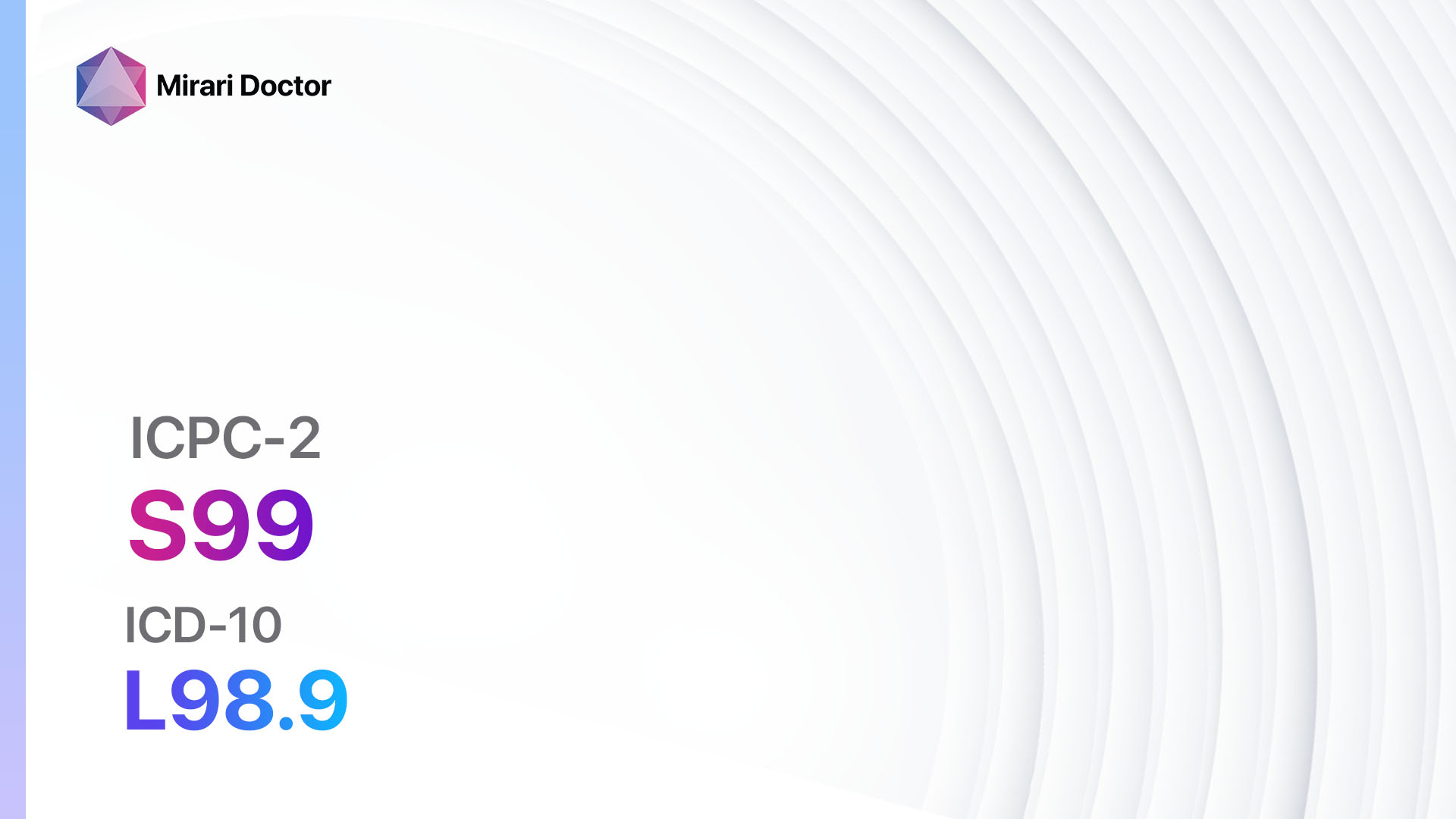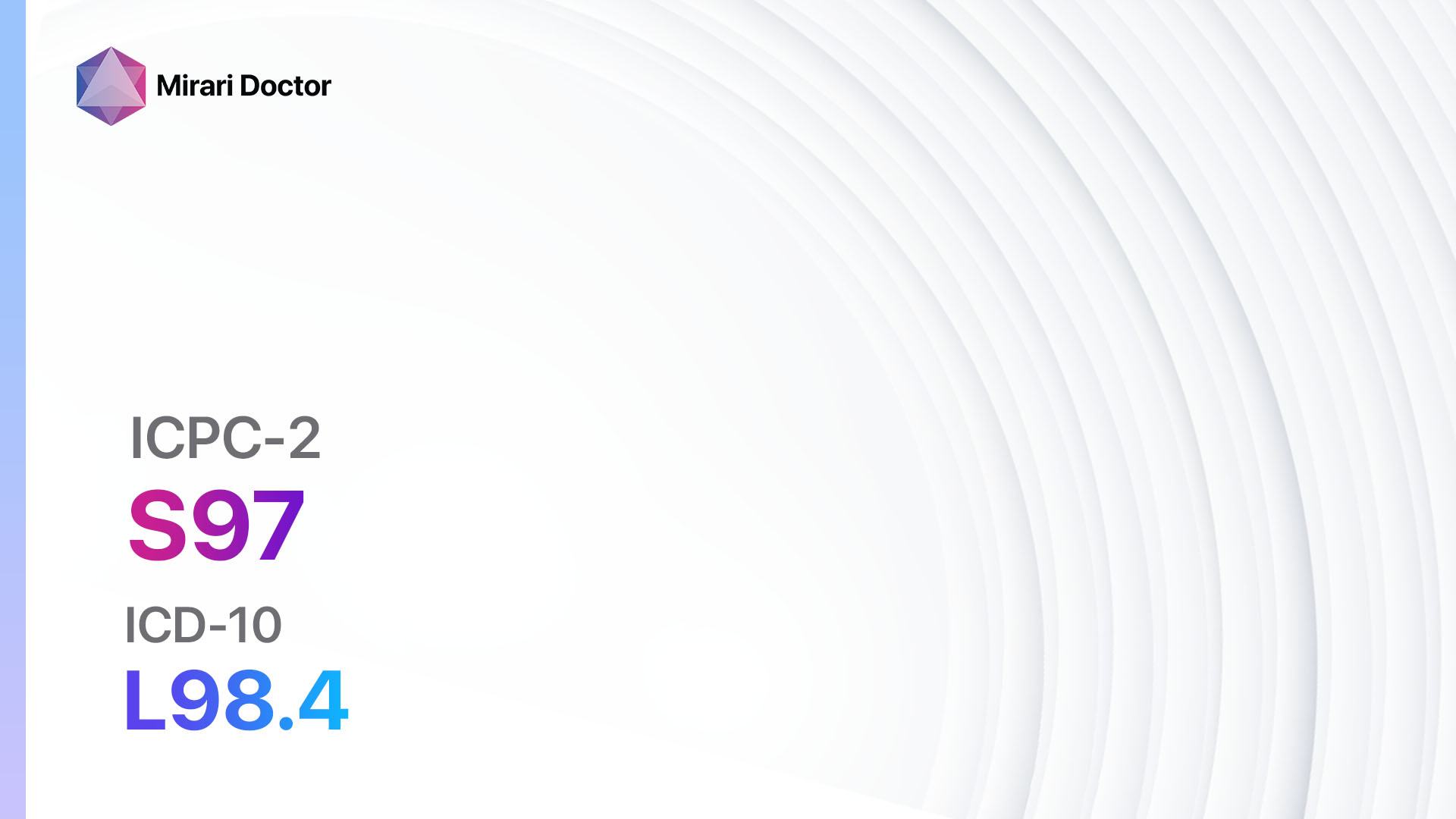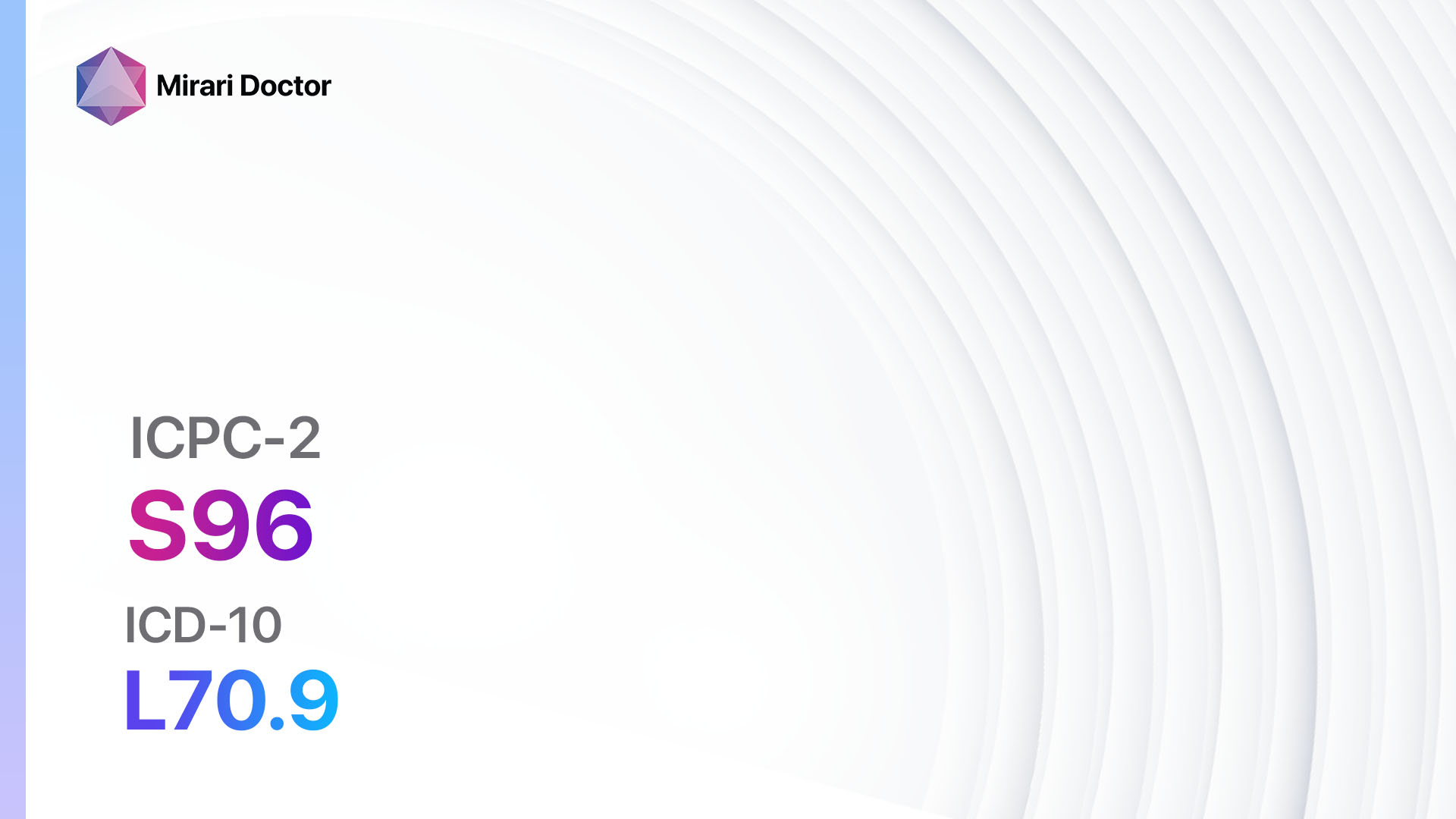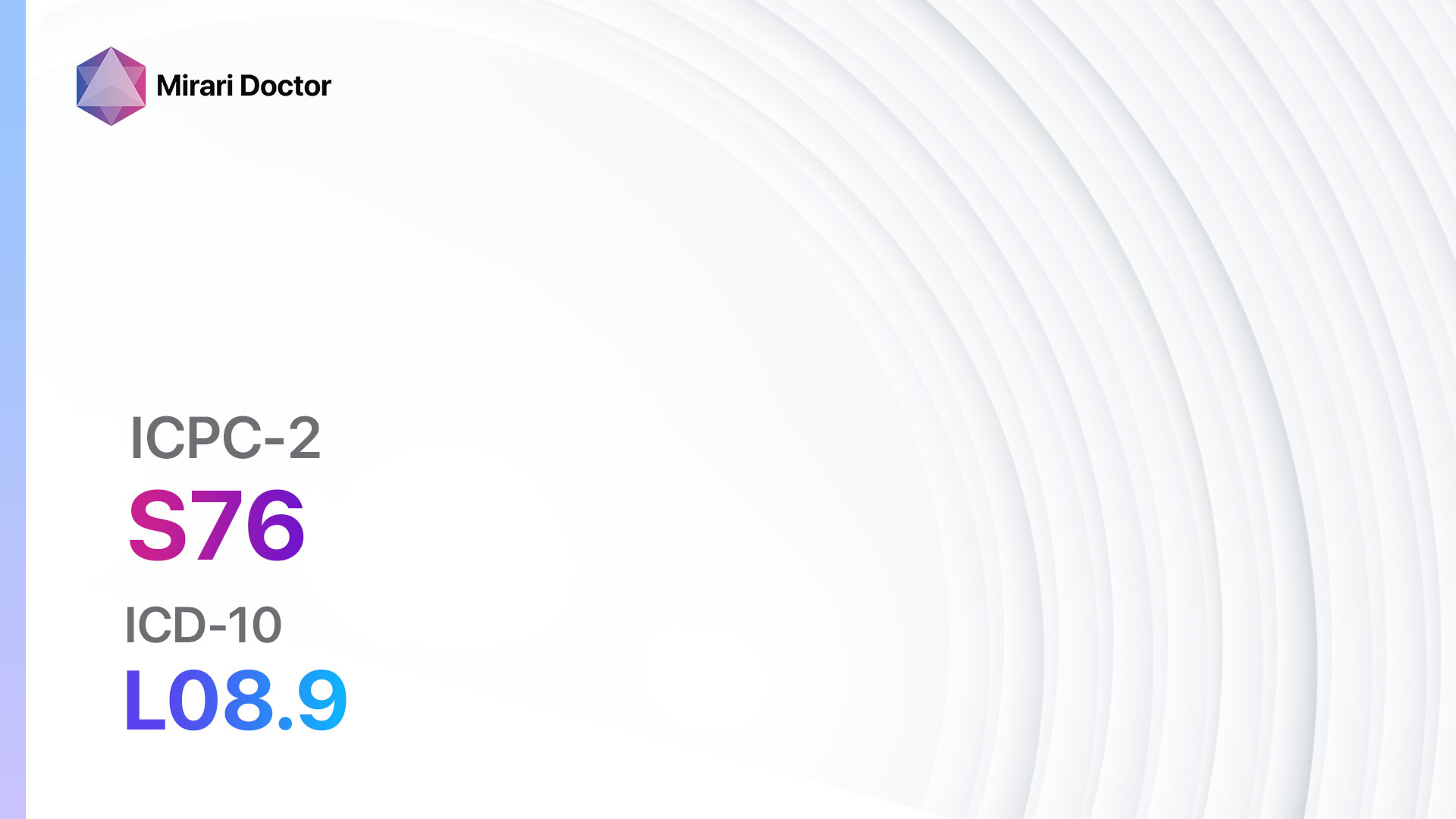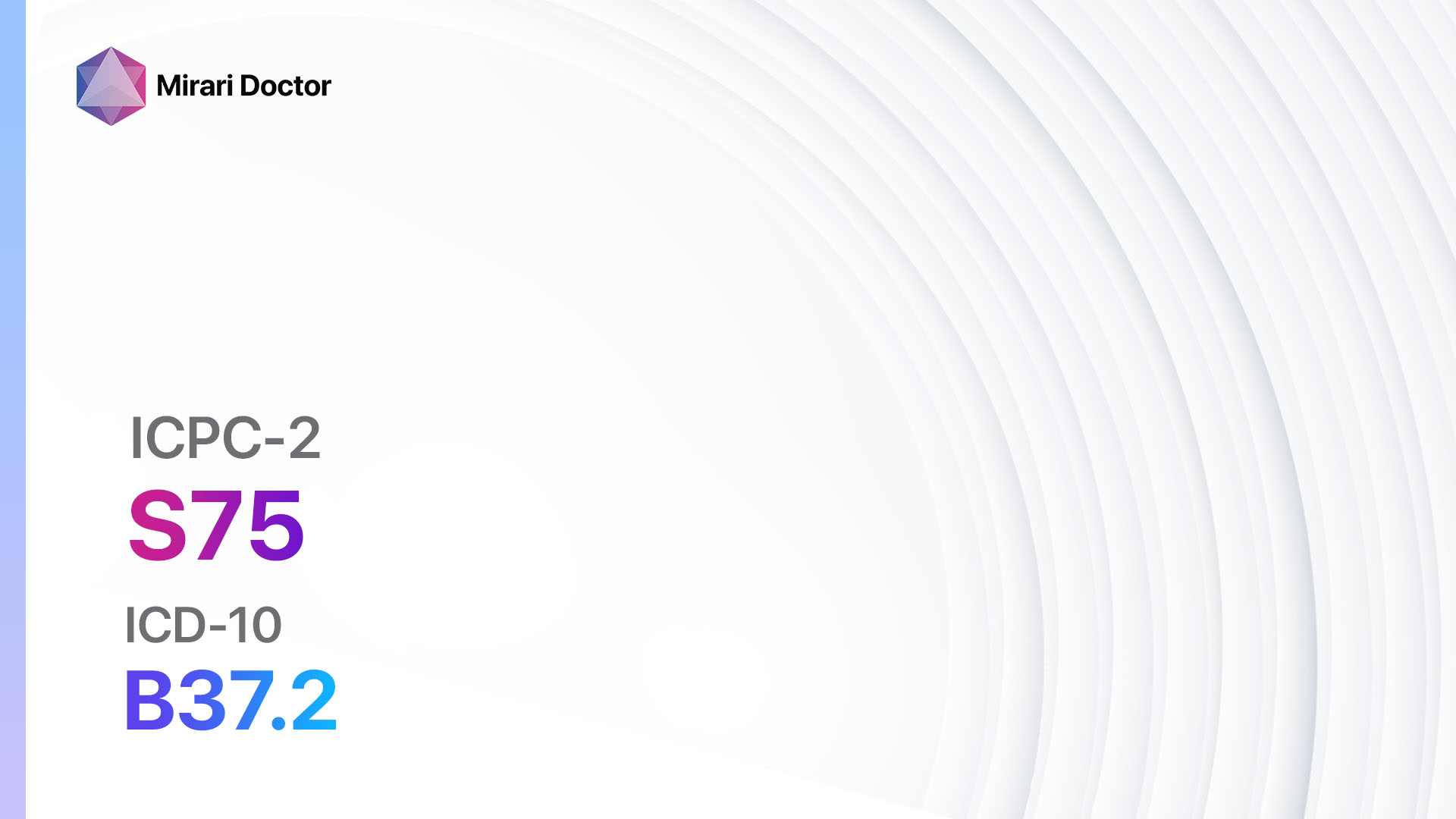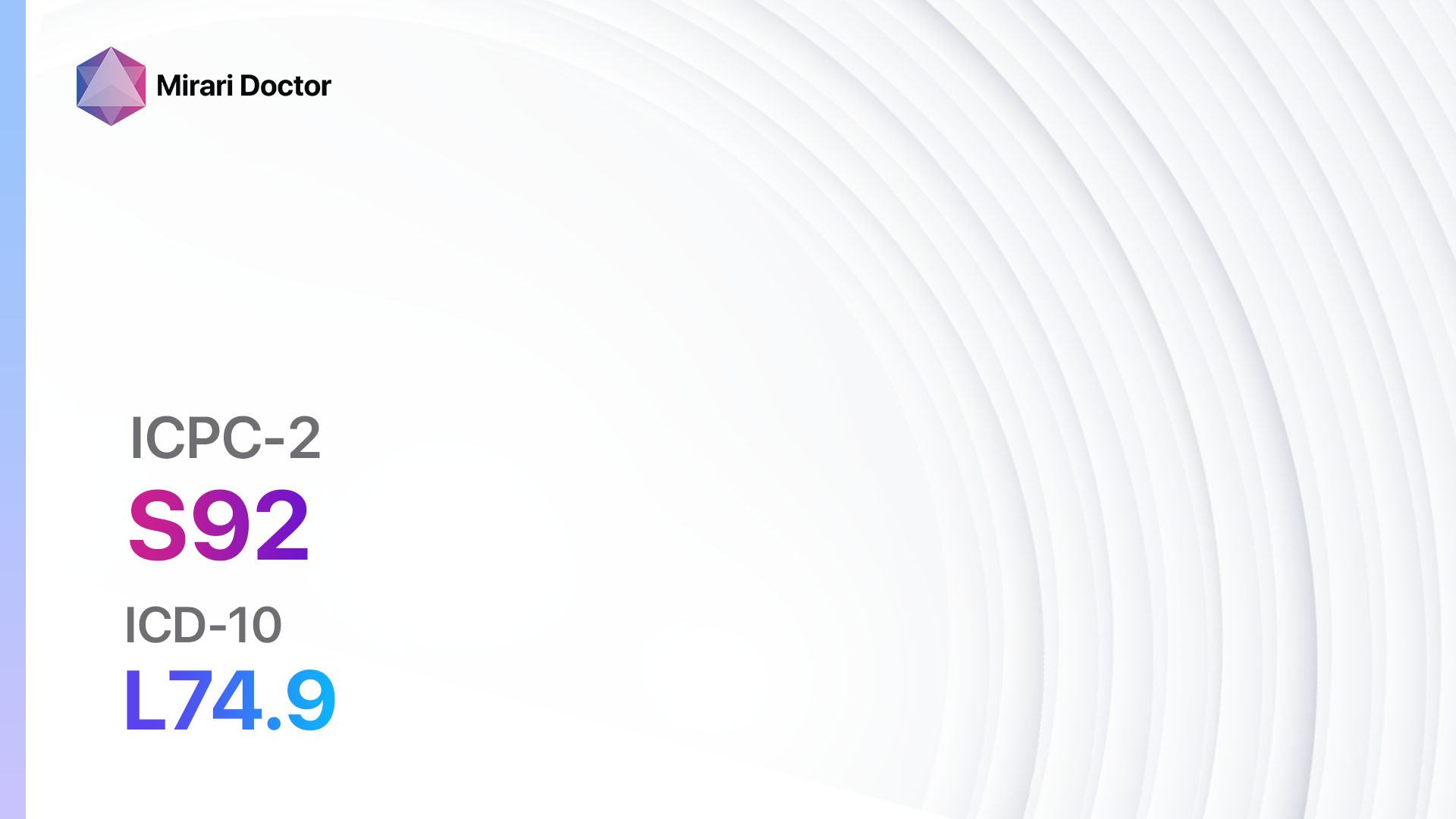
Introduction
Sweat gland disease refers to a group of conditions that affect the sweat glands, leading to various symptoms and complications. These conditions can range from benign and self-limiting to chronic and debilitating.[1] The aim of this guide is to provide healthcare professionals with a comprehensive overview of sweat gland disease, including its symptoms, causes, diagnostic steps, possible interventions, and lifestyle interventions.
Codes
Symptoms
- Excessive sweating (hyperhidrosis): Excessive sweating that is not related to physical activity or temperature changes.[2]
- Sweating that disrupts daily activities and causes social embarrassment.[3]
- Sweating that occurs on specific areas of the body, such as the palms, soles of the feet, or underarms.[4]
- Sweating that is accompanied by a foul odor (bromhidrosis).[5]
- Sweating that is associated with pain or discomfort.[6]
Causes
- Primary focal hyperhidrosis: The exact cause is unknown, but it is believed to be related to overactivity of the sweat glands.[7]
- Secondary hyperhidrosis: Excessive sweating caused by an underlying medical condition, such as diabetes, menopause, or hyperthyroidism.[8]
- Bromhidrosis: Caused by the breakdown of sweat by bacteria on the skin, leading to a foul odor.[9]
Diagnostic Steps
Medical History
- Gather information about the patient’s symptoms, including the location, duration, and severity of sweating.
- Ask about any associated symptoms, such as pain, discomfort, or foul odor.
- Inquire about any medical conditions or medications that may be contributing to the excessive sweating.
- Assess the impact of sweating on the patient’s daily activities and quality of life.
Physical Examination
- Inspect the areas of excessive sweating for any signs of inflammation, infection, or other skin abnormalities.
- Palpate the affected areas to assess for tenderness or discomfort.
- Evaluate the patient’s overall skin condition and hygiene.
- Assess for any associated symptoms, such as body odor or skin discoloration.
Determine Severity
- Classify the disease based on severity and depth, if applicable:
- Mild: Excessive sweating that does not significantly impact daily activities or quality of life.
- Moderate: Excessive sweating that interferes with daily activities and causes social embarrassment.
- Severe: Excessive sweating that significantly impairs daily activities and causes significant social and emotional distress.[10]
Laboratory Tests
- No specific laboratory tests are required for the diagnosis of sweat gland disease. However, certain tests may be performed to rule out underlying medical conditions or to assess the severity of sweating:
- Blood tests: To check for hormonal imbalances, such as hyperthyroidism or menopause.
- Sweat test: To measure the amount of sweat produced by the sweat glands.
- Skin biopsy: To evaluate the skin for any underlying abnormalities or infections.
Diagnostic Imaging
- No diagnostic imaging is necessary for the diagnosis of sweat gland disease.
Other Tests
- No other specific tests are necessary for the diagnosis of sweat gland disease. However, additional tests may be performed based on the clinical presentation:
- Bacterial culture: To identify the specific bacteria causing bromhidrosis.
- Allergy testing: To identify any allergens that may be triggering excessive sweating.
- Hormone testing: To assess for hormonal imbalances that may be contributing to excessive sweating.
Follow-up and Patient Education
- Schedule regular follow-up appointments to monitor the patient’s progress and adjust treatment as needed.
- Provide patient education on the condition, including its causes, treatment options, and lifestyle modifications.
- Encourage the patient to maintain good hygiene practices and to seek medical attention if symptoms worsen or new symptoms develop.
Possible Interventions
Traditional Interventions
Medications:
Top 5 drugs for sweat gland disease:
- Antiperspirants (e.g., Aluminum chloride hexahydrate):
- Cost: $5-$15 per bottle.
- Contraindications: Allergy to aluminum chloride.
- Side effects: Skin irritation, itching, burning.
- Severe side effects: None reported.
- Drug interactions: None reported.
- Warning: Avoid applying to broken or irritated skin.
- Botulinum toxin injections (e.g., Botox):
- Cost: $300-$1000 per treatment session.
- Contraindications: Allergy to botulinum toxin.
- Side effects: Pain at the injection site, temporary muscle weakness.
- Severe side effects: None reported.
- Drug interactions: None reported.
- Warning: Temporary relief, repeat injections required every 3-6 months.
- Anticholinergic medications (e.g., Glycopyrrolate):
- Cost: $50-$100 per month.
- Contraindications: Glaucoma, urinary retention, gastrointestinal obstruction.
- Side effects: Dry mouth, blurred vision, constipation.
- Severe side effects: None reported.
- Drug interactions: None reported.
- Warning: May cause drowsiness, avoid alcohol and other sedatives.
- Tricyclic antidepressants (e.g., Amitriptyline):
- Cost: $10-$50 per month.
- Contraindications: Recent heart attack, narrow-angle glaucoma.
- Side effects: Dry mouth, drowsiness, constipation.
- Severe side effects: Irregular heart rhythm, seizures.
- Drug interactions: MAO inhibitors, alcohol.
- Warning: May take several weeks to see improvement, avoid abrupt discontinuation.
- Calcium channel blockers (e.g., Nifedipine):
- Cost: $10-$50 per month.
- Contraindications: Hypotension, heart failure.
- Side effects: Dizziness, headache, flushing.
- Severe side effects: Irregular heart rhythm, heart attack.
- Drug interactions: Grapefruit juice, beta-blockers.
- Warning: Regular blood pressure monitoring required.
Alternative Drugs:
- Glycopyrrolate cream: Topical application for localized sweating.
- Clonidine: Alpha-2 agonist that can help reduce sweating.
- Propranolol: Beta-blocker that may be effective for anxiety-related sweating.
- Oxybutynin: Anticholinergic medication used for excessive sweating.
- Gabapentin: Anticonvulsant that may help reduce sweating.
Surgical Procedures:
- Sweat gland removal: Surgical removal of the sweat glands in the affected area.
- Cost: $2000-$5000 per procedure.
- Contraindications: None reported.
- Side effects: Pain, swelling, scarring.
- Severe side effects: Infection, bleeding.
- Drug interactions: None reported.
- Warning: Permanent solution, potential for compensatory sweating in other areas.
Alternative Interventions
- Acupuncture: May help improve blood flow and reduce sweating.
- Cost: $60-$120 per session.
- Iontophoresis: Involves passing a mild electrical current through water to reduce sweating.
- Cost: $500-$1000 for a device.
- Herbal supplements: Certain herbs, such as sage and witch hazel, may help reduce sweating.
- Cost: Varies depending on the specific supplement.
- Lifestyle modifications: Avoiding triggers, such as spicy foods or caffeine, and wearing breathable clothing.
- Cost: Minimal.
Lifestyle Interventions
- Good hygiene practices: Regular bathing and use of antiperspirants.
- Wearing breathable clothing: Choose natural fabrics, such as cotton, to allow for better air circulation.
- Avoiding triggers: Identify and avoid triggers that may worsen sweating, such as spicy foods or alcohol.
- Stress management techniques: Practice relaxation techniques, such as deep breathing or meditation, to reduce stress-induced sweating.
- Weight management: Maintaining a healthy weight can help reduce sweating.
- Use of absorbent materials: Use absorbent materials, such as sweat pads or underarm shields, to absorb excess sweat.
It is important to note that the cost ranges provided are approximate and may vary depending on the location and availability of the interventions.
Mirari Cold Plasma Alternative Intervention
Understanding Mirari Cold Plasma
- Safe and Non-Invasive Treatment: Mirari Cold Plasma is a safe and non-invasive treatment option for various skin conditions. It does not require incisions, minimizing the risk of scarring, bleeding, or tissue damage.
- Efficient Extraction of Foreign Bodies: Mirari Cold Plasma facilitates the removal of foreign bodies from the skin by degrading and dissociating organic matter, allowing easier access and extraction.
- Pain Reduction and Comfort: Mirari Cold Plasma has a local analgesic effect, providing pain relief during the treatment, making it more comfortable for the patient.
- Reduced Risk of Infection: Mirari Cold Plasma has antimicrobial properties, effectively killing bacteria and reducing the risk of infection.
- Accelerated Healing and Minimal Scarring: Mirari Cold Plasma stimulates wound healing and tissue regeneration, reducing healing time and minimizing the formation of scars.
Mirari Cold Plasma Prescription
Video instructions for using Mirari Cold Plasma Device – S92 Sweat gland disease (ICD-10:L74.9)
| Mild | Moderate | Severe |
| Mode setting: 1 (Infection) Location: 0 (Localized) Morning: 15 minutes, Evening: 15 minutes |
Mode setting: 1 (Infection) Location: 0 (Localized) Morning: 30 minutes, Lunch: 30 minutes, Evening: 30 minutes |
Mode setting: 1 (Infection) Location: 0 (Localized) Morning: 30 minutes, Lunch: 30 minutes, Evening: 30 minutes |
| Mode setting: 2 (Wound Healing) Location: 0 (Localized) Morning: 15 minutes, Evening: 15 minutes |
Mode setting: 2 (Wound Healing) Location: 0 (Localized) Morning: 30 minutes, Lunch: 30 minutes, Evening: 30 minutes |
Mode setting: 2 (Wound Healing) Location: 0 (Localized) Morning: 30 minutes, Lunch: 30 minutes, Evening: 30 minutes |
| Total Morning: 30 minutes approx. $5 USD, Evening: 30 minutes approx. $5 USD |
Total Morning: 60 minutes approx. $10 USD, Lunch: 60 minutes approx. $10 USD, Evening: 60 minutes approx. $10 USD, |
Total Morning: 60 minutes approx. $10 USD, Lunch: 60 minutes approx. $10 USD, Evening: 60 minutes approx. $10 USD, |
| Usual treatment for 7-60 days approx. $70 USD – $600 USD | Usual treatment for 6-8 weeks approx. $1,260 USD – $1,680 USD |
Usual treatment for 3-6 months approx. $2,700 USD – $5,400 USD
|
 |
|
Use the Mirari Cold Plasma device to treat Sweat gland disease effectively.
WARNING: MIRARI COLD PLASMA IS DESIGNED FOR THE HUMAN BODY WITHOUT ANY ARTIFICIAL OR THIRD PARTY PRODUCTS. USE OF OTHER PRODUCTS IN COMBINATION WITH MIRARI COLD PLASMA MAY CAUSE UNPREDICTABLE EFFECTS, HARM OR INJURY. PLEASE CONSULT A MEDICAL PROFESSIONAL BEFORE COMBINING ANY OTHER PRODUCTS WITH USE OF MIRARI.
Step 1: Cleanse the Skin
- Start by cleaning the affected area of the skin with a gentle cleanser or mild soap and water. Gently pat the area dry with a clean towel.
Step 2: Prepare the Mirari Cold Plasma device
- Ensure that the Mirari Cold Plasma device is fully charged or has fresh batteries as per the manufacturer’s instructions. Make sure the device is clean and in good working condition.
- Switch on the Mirari device using the power button or by following the specific instructions provided with the device.
- Some Mirari devices may have adjustable settings for intensity or treatment duration. Follow the manufacturer’s instructions to select the appropriate settings based on your needs and the recommended guidelines.
Step 3: Apply the Device
- Place the Mirari device in direct contact with the affected area of the skin. Gently glide or hold the device over the skin surface, ensuring even coverage of the area experiencing.
- Slowly move the Mirari device in a circular motion or follow a specific pattern as indicated in the user manual. This helps ensure thorough treatment coverage.
Step 4: Monitor and Assess:
- Keep track of your progress and evaluate the effectiveness of the Mirari device in managing your Sweat gland disease. If you have any concerns or notice any adverse reactions, consult with your health care professional.
Note
This guide is for informational purposes only and should not replace the advice of a medical professional. Always consult with your healthcare provider or a qualified medical professional for personal advice, diagnosis, or treatment. Do not solely rely on the information presented here for decisions about your health. Use of this information is at your own risk. The authors of this guide, nor any associated entities or platforms, are not responsible for any potential adverse effects or outcomes based on the content.
Mirari Cold Plasma System Disclaimer
- Purpose: The Mirari Cold Plasma System is a Class 2 medical device designed for use by trained healthcare professionals. It is registered for use in Thailand and Vietnam. It is not intended for use outside of these locations.
- Informational Use: The content and information provided with the device are for educational and informational purposes only. They are not a substitute for professional medical advice or care.
- Variable Outcomes: While the device is approved for specific uses, individual outcomes can differ. We do not assert or guarantee specific medical outcomes.
- Consultation: Prior to utilizing the device or making decisions based on its content, it is essential to consult with a Certified Mirari Tele-Therapist and your medical healthcare provider regarding specific protocols.
- Liability: By using this device, users are acknowledging and accepting all potential risks. Neither the manufacturer nor the distributor will be held accountable for any adverse reactions, injuries, or damages stemming from its use.
- Geographical Availability: This device has received approval for designated purposes by the Thai and Vietnam FDA. As of now, outside of Thailand and Vietnam, the Mirari Cold Plasma System is not available for purchase or use.
References
- Nawrocki S, Cha J. The Etiology, Diagnosis, and Management of Hyperhidrosis: A Comprehensive Review: Etiology and Clinical Work-up. J Am Acad Dermatol. 2019;81(3):657-666.
- Doolittle J, Walker P, Mills T, Thurston J. Hyperhidrosis: an update on prevalence and severity in the United States. Arch Dermatol Res. 2016;308(10):743-749.
- Kamudoni P, Mueller B, Halford J, Schouveller A, Stacey B, Salek MS. The impact of hyperhidrosis on patients’ daily life and quality of life: a qualitative investigation. Health Qual Life Outcomes. 2017;15(1):121.
- Haider A, Solish N. Focal hyperhidrosis: diagnosis and management. CMAJ. 2005;172(1):69-75.
- Callejas MA, Grimalt R, Cladellas E. Hyperhidrosis Update. Actas Dermosifiliogr. 2010;101(2):110-118.
- Strutton DR, Kowalski JW, Glaser DA, Stang PE. US prevalence of hyperhidrosis and impact on individuals with axillary hyperhidrosis: results from a national survey. J Am Acad Dermatol. 2004;51(2):241-248.
- Brackenrich J, Fagg C. Hyperhidrosis. In: StatPearls. Treasure Island (FL): StatPearls Publishing; 2022.
- Cheshire WP, Fealey RD. Drug-induced hyperhidrosis and hypohidrosis: incidence, prevention and management. Drug Saf. 2008;31(2):109-126.
- Shirasu M, Touhara K. The scent of disease: volatile organic compounds of the human body related to disease and disorder. J Biochem. 2011;150(3):257-266.
- Solish N, Bertucci V, Dansereau A, et al. A comprehensive approach to the recognition, diagnosis, and severity-based treatment of focal hyperhidrosis: recommendations of the Canadian Hyperhidrosis Advisory Committee. Dermatol Surg. 2007;33(8):908-923.
Related articles
Made in USA



